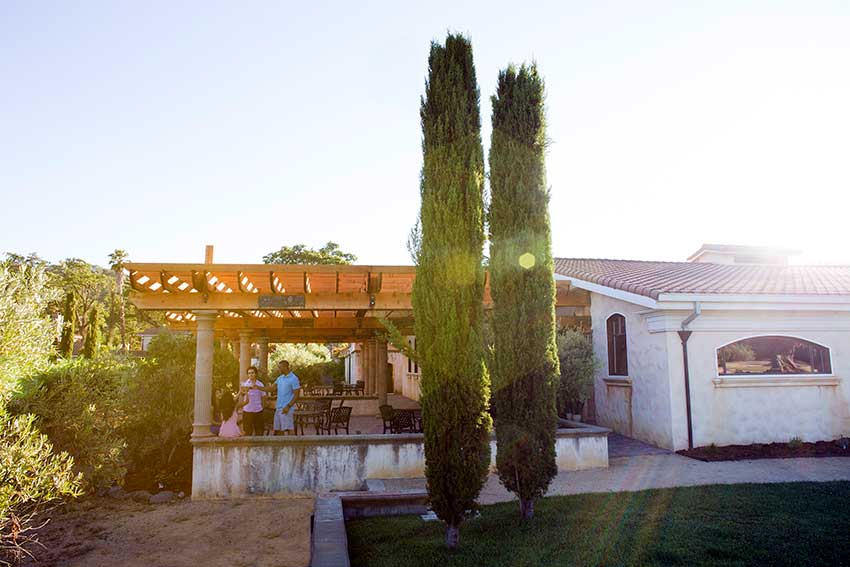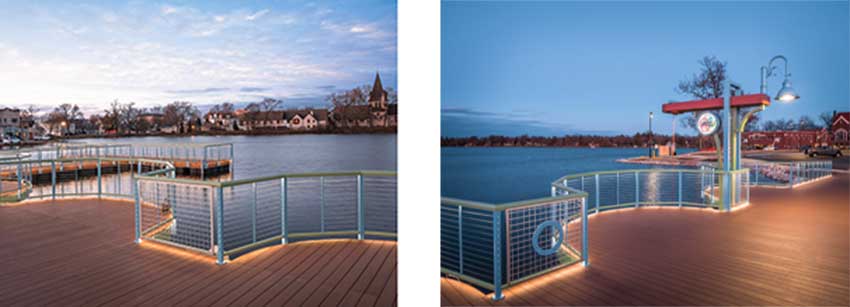Transforming Outdoor Spaces: Placemaking
OUTDOOR ROOFTOP DECK CASE STUDY

Photos: Kyle J Caldwell; courtesy of Bison Innovative Products
Project: Mass General Brigham Administrative Campus
Location: Somerville, Mass.
Architect: Gensler
Landscape Architect: OJB Landscape Architecture
The Project: Mass General Brigham is Massachusetts’ largest employer and oversees some of the most renowned hospitals in the country. The healthcare provider’s new 825,000-square-foot headquarters features an employee campus meant to focus on community and sustainability.
The Challenge: The goal for the project was set at a LEED gold certified building with sustainable features which include landscape features that absorb rainwater, solar panels in the parking garage to supply up to 30 percent of the campus’ power, and a rooftop deck with a garden retreat and cafeteria. While most of these strategies are straightforward, the question became how best to create the outdoor rooftop deck.
The Solution: An adjustable pedestal support system was selected as the best solution. Supported by adjustable pedestals, the rooftop deck complements comfortable lounge seating around a rooftop cafeteria. These rooftop decks provide opportunities for building users to engage in physical activity, participate in social interaction, or retreat to a quiet refuge. Dense with vegetation, these decks also help to improve employee spirit and decrease employee absenteeism, thus improving overall productivity. Per OJB Landscape Architecture’s design, custom-made, 30-by-30-inch, smooth Ipê wood tiles were fabricated to match the dimensions of the fenestration adjacent to the deck, creating an attractive linear design.
The Results: The new rooftop deck is lush with trees and foliage providing easy access to fresh air and outdoor dining for all people who are using the facility.
MATERIAL CASE STUDY

Photo courtesy of Humboldt Sawmill Company
Project: Jeriko Estate Resort and Winery
Location: Hopland, Calif.
The Project: Jeriko Estate Resort and Winery in Hopland, Calif., is a certified organic winery with a unique business model: in addition to selling estate wines, guests are able to enjoy the property as an overnight resort.
Throughout the 75-acre, Italian villa-style property, there are casitas, villas, and suites that can accommodate up to 45 guests overnight. With limited hotels nearby, Jeriko Estate is uniquely positioned to welcome guests to the area to “stay and play.”
The Challenge: The California sun is appealing but can be hot. To enhance guests’ enjoyment of the property, owner Danny Fetzer installed two redwood pergolas. The larger one is outside the main tasting room, and a second is attached to one of the casitas on the property. The larger pergola provides a cool outdoor space for patrons who want to experience the magnificence of the property. The smaller pergola creates an ecosystem within the property designed for the guests who stay there. Fetzer plans to add additional redwood pergolas over time.
The Solution: Fetzer chose redwood because of its durability: “Redwood can withstand the elements of time and weather.” He wanted to install something that would last, required minimal maintenance, and did not need to be replaced after a short period of time. Less time spent maintaining the pergolas gives him the ability to focus on the needs of his guests.
Fetzer was also drawn to the sustainability of redwood. Sourced from nearby Forest Stewardship Council® (FSC®C013133) certified forestlands, redwood trees are indigenous and have been used locally for centuries. Modern forestry practices mean that more redwood trees are grown each year than are harvested and additional protections are put in place around old growth stands, flora and fauna, and water courses, to name a few. This fits with Jeriko’s organic and sustainable values.
The superior functionality of redwood was also important to Fetzer. He wanted to create an outdoor space where guests could enjoy the beautiful views of the property while remaining cool and comfortable: “When large events are hosted at Jeriko Estate, the pergolas create a perfect, cool atmosphere so guests can relax and enjoy the special day.” The entire patio serves as a pleasant oasis from the heat: it provides shade, and the redwood remains cool to the touch, even on a hot day.
Fetzer hopes to attract more events, such as weddings, to Jeriko Estate. The redwood pergolas have helped beautify the property. Fetzer points out that, “We decided on redwood pergolas largely because of the aesthetics. The look of the exposed wood mirrors the interior design of the tasting room.”
The Results: The redwood shade structures encourage guests to enjoy the outdoor beauty of the winery. They transform a hot day into a pleasant afternoon, creating a comfortable atmosphere for sipping Jeriko wines. The redwood pergolas have proven invaluable to the property for other reasons as well.
COILED WIRE FABRIC CASE STUDY

Photos courtesy of Cascade Architectural
Project: Firemen’s Park
Location: City of Chaska, Minn.
Design: LHB
The Project: The City of Chaska, Minn., is known for having one of the best parks, trails, and open space systems in the Minneapolis-St. Paul metropolitan area. City and neighborhood parks are located throughout the city, many with amenities such as playground equipment, picnic shelters, and grills. Firemen’s Park features a boardwalk, Clayhole Public Beach, an interactive fountain, a performance stage, and paddleboat/paddleboard rentals. It is also the location of the Chaska Curling Center, which is the national training site for USA Curling.
The Challenge: Based on a city initiative for creating activity to support downtown Chaska, the design firm of LHB partnered with the 292 Design Group to help the City of Chaska develop additional facilities to create a park that could be viewed as truly a regional destination.
The Solution: A master plan was developed for the project that included extensive renovations at Firemen’s Park and nearby Schimelpfenig Park. The master planning process brought together park users and identified interest groups so the needs and desires of each group could be understood and worked into the overall plan.
The resulting objectives of the planning process included maintaining and enhancing existing park elements that have been popular to Chaska residents. It also included developing a trailhead in the downtown business district, creating a continuous walkway around Clayhole Lake, renovating park sites to accommodate as many different constituents as possible, and incorporating the meaningful history of this site.
A focal point of the renovation includes a new outdoor pavilion space along the waterway. A cable hung cantilevered structure projects out in one direction to face the water and in the other direction to cover a stage area for outdoor events. In between the structural support members, coiled wire fabric is draped to provide some sun and weather screening during the day. At night, the coiled wire fabric is illuminated to create a striking luminous overhead surface with the ability to change color and light intensity based on lighting controls. The overall result is a year-round amenity that is quite attractive and usable whether in the daytime or nighttime hours.
The Results: Building on the excitement generated during the master planning process, Firemen’s Park moved quickly through design and construction. The completed renovation has proven to be tremendously popular with the community and with visitors.
RAILING CASE STUDY

Photos courtesy of Feeney, Inc.
Project: Oconomowoc Waterfront
Location: Oconomowoc, Wisc.
Design: Stantec
The Project: The city of Oconomowoc, Wisc., had decided to undertake a project designed to reinvigorate the town’s waterfront area. The project called for a substantial overhaul of the existing public space, including replacing the railings near the shoreline and adding railings to a recently built T-shaped fishing pier. The city engaged the Milwaukee office of the design and engineering firm Stantec to specify the railings.
The Challenge: Several challenges had to be addressed when determining the best railing solution. First, ongoing exposure to significant moisture on the lakefront could cause the railings to deteriorate over time. Notably, the metals in the previous railing system had been mismatched, causing the railings to corrode wherever the dissimilar metals met – and requiring the city to repaint the posts every few years.
Moreover, regular use of the railings by the public would subject them to high levels of wear and tear. Finally, to maintain the integrity of the lake, the city hoped to reduce the incidence of cups and bottles falling into the water when set on the railings.
Stantec design engineer Kevin Kimmes set out to find a railing solution that would not only be durable and stand up to the elements but also require minimal maintenance. It was equally important that the railings preserve the view of the lake and adjacent areas.
The Design Solution: To optimize visibility and provide an inviting ambiance for evening visitors to the boardwalk, Kimmes recommended going with a railing system that offered lighting on both the top and bottom rails. In addition, the city council was leaning toward colored railings, which would harmonize with existing architectural elements and, crucially, eliminate the need for repainting.
Due to its weather-resistant, marine-grade stainless steel construction and ability to maintain clear sightlines, Kimmes and his team determined that cable rail infill was the best solution. They also liked the idea of powder-coated aluminum railings, which would provide a range of color options while significantly reducing maintenance requirements.
After careful evaluation, the firm chose an aluminum railing system with cable infill and LED lighting. “This solution offered the right connections and materials between the posts and cable, which was important to avoid corrosion,” noted Kimmes. The specifications called for an AAMA 2604 powder coating process, which is ideally suited for saltwater environments, and is even better in freshwater applications. The team also specified soft, even lighting created by an LED lighting incorporated into the rails. Additionally, the firm selected elliptical top rails to discourage boardwalk visitors from placing food and drinks on the railings.
The Results: The completed project has been viewed as a success in the community. The colorful railings tie together the boardwalk with the surrounding area while enabling visitors to enjoy an unimpeded view of the lake as they walk along the boardwalk. Meanwhile, the increased pedestrian traffic has transformed the waterfront area into a major business center for local merchants.
Peter J. Arsenault, FAIA, NCARB, LEED-AP is a nationally known architect and a prolific author advancing sustainable residences through better design.www.pjaarch.com, www.linkedin.com/in/pjaarch



